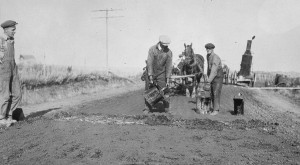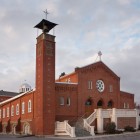Then & Now
ST. ALBERT TRAIL
December, 2015
Back in 1860, the familiar path we now call St. Albert Trail was part of a main shipping route, footpath and horse trail between Fort Edmonton and Lac Ste. Anne. One hundred years later, in 1960, it became a four-lane highway that linked St. Albert to Edmonton. Many improvements have been made over the years and, today, the history of St. Albert Trail continues to be written. Here are a few of the highlights.
1800s
In 1806, James Bird of the Hudson Bay Company wrote of the abundance of fish at “God’s Lake” (Lac Ste. Anne). The supply of fish was important to the early settlers. These early shipments of fish by horse cart influenced where the St. Albert Trail would eventually be located.
In the winter of 1858, the explorer John Palliser wrote in his journal that Lac St. Anne was a source of whitefish “which are delicious eating, are of an average size of four pounds.”
Two years later, Hudson Bay Company journal entries from the winter of 1860/61 indicate that some 30,000 to 40,000 whitefish were shipped to Fort Edmonton annually to supplement the dwindling supply of buffalo meat. The regular shipments by horse-drawn cart came on that same trail.
In 1859, Grey Nuns arrive to assist Father Lacombe, after travelling 51 days from St. Boniface.
In 1889, the first representative of St. Albert on the North-West Commission opened the initial road from St. Albert to Edmonton. St. Albert Trail was officially established.

1900s
In 1902, by decree of the Northwest Territories, our town got its official start when St. Albert was incorporated.
In 1909, Raymond Brutinel led a group of investors and businessmen to develop a proposal for the Interurban Railway to operate between St. Albert and Edmonton along St. Albert Trail. Despite a rather convoluted process of stops and starts, the railway began operating on December 22, 1913. Service abruptly ended on April 1, 1914 with a tremendous fire that consumed the car, barn and contents. It never operated again.
In 1940, Provincial Highway 2 was constructed through the town of St. Albert bringing with it a new bridge over the Sturgeon River.
In 1960, construction began on a four-lane, graded highway from St. Albert to Edmonton. At that time, St. Albert’s population was 3,190.
 2000s
2000s
On February 26, 2007, the St. Albert Trail between St. Albert and the City of Edmonton was renamed Mark Messier Trail—St. Albert’s nod of thanks to Messier for the time he lived in St. Albert and played with the St. Albert Saints in the Alberta Junior Hockey League.
In April 2012, the first meeting of the newly established St. Albert Trail Improvement Plan Committee, a task force of the Mayor, launched with a 15-month mandate to address the following concerns and goals:
Aesthetics, Mobility & Accessibility: maximize greenery, solidify St. Albert’s brand, provide consistent appearance, recognizing the culture and history of the trail.
Business & Community Support: acknowledge the diverse interests and needs of drivers, pedestrians and business owners.
Accommodate all modes of travel including transit users, pedestrians, cyclists, motorists, and users with unique mobility needs. Improve wayfinding.
Cost Effectiveness: cultivate pride in St. Albert Trail while encouraging entre-preneurial pursuits.
Maintenance & Safety: balancing ongoing maintenance costs, safety and bylaw compliance.
Sixteen recommendations resulted from the committee’s work, including implementing a long-term sidewalk strategy, engaging business operators and building owners to support key initiatives and developing a median rehabilitation strategy.
Now
Planning is currently underway for a proposed Edmonton to St. Albert LRT extension to run along the eastside of St. Albert Trail. As history may have it, Raymond Brutinel’s 100-year-old vision of an interurban railway may very well form part of our future—again. t8n
Caption:
Men working on the St. Albert Trail Bituminized Road Experiment, 1923.
Archival Credit: Provincial Archives of Alberta, A11235
St. Albert at rush hour, 2015.
Did You Know?
St. Albert of Louvain, the namesake of St. Albert Road and, later, St. Albert Trail, was martyred on November 24, 1192—murdered in his own church on emperor’s orders.













